The "Moving" Campaign
This campaign was designed as an assignment on the Social Media Communication subject
The Social Issue
Body positivity issues emerged in the 1960s in reaction to the emergence of anti-fat in the US and Canada, aimed to increase the visibility and normalise the underrepresented bodies, those that did not fit the beauty standard, in traditional media. It has several core components, including body appreciation, acceptance, inner positivity, etc. Positive body image is associated with better social well-being and psychological. However, some research suggests the potential drawbacks. Positive body image may lead to decrease motivation for doing weight loss and other healthy behaviours (Cohen et al., 2019). Therefore, the “Moving” campaign aims to make plus-size people realise that despite the need to accept their body size, they still need to be physically active because they deserve a healthy body.
It is hard to find a previous campaign that is comparable to this “Moving” campaign because they normally have the budget that allows them to extensively deliver the campaign on various platforms. For example, the Body Image Movement delivered their campaign through the website, YouTube, Instagram, Facebook, and Twitter. The idea of delivering the campaign through Instagram and Facebook will potentially be adopted in the “Moving” campaign, considering that both are free platforms and potentially suitable for the target audience. Besides, the cost of producing Instagram and Facebook seems to be cheaper than YouTube. Therefore, due to the high production cost, the “Moving” campaign will not utilise YouTube even though it is potentially suitable for the target audience.
Audience Overview
The intended target audiences are Australians aged 25-34. This group has more than 50% of people with obesity or obese and still fit for the social media campaign target as they are actively participating in social media. This is also the age group in which people start being busy with work and only have limited time to take care of their health. Therefore, the campaign will provide a solution for them to stay active and healthy by promoting simple tips to stay active on busy days.
Automated Management and Analytics
The campaign will utilise the Content Planner feature from Meta Business Suite to do post automation. As content will be delivered through Facebook Page and Instagram, both accounts will be connected under the Meta Business Suite, which is free. Therefore, there is no need to subscribe to other social media manager tools. It is good for a zero-budget campaign.
Data Analytics will also be collected from the Meta Business Suite. By connecting the Facebook Page and Instagram account under the Meta Business suite, data about Reach, Likes, Comments, Shares, Followers, and even Profile Visits, from both accounts can be obtained. This data will tell how the contents perform and there might be possibilities to do content adjustment even though everything had been planned. In a case when the campaign is done with a budget, low-performing content can be boosted through advertisement. In this case, low-performing content can be boosted by editing captions to encourage conversation, adding some relevant hashtags, and asking the partner/collaborator to share it with their audience.
Community Manager Approaches
Community Manager will do research about the problem in the society and how to solve it by using a campaign. Analysing who will be the target audience will be done by considering their demographic, behaviour, and how they contribute or get affected by the issue. The suitable channel, delivery method, and data analytics method will be decided by considering the audience characteristics and organisational capability.
Platforms
Considering the target audiences’ age group, the most suitable channels to deliver the campaign are Facebook and Instagram. According to the demographic distribution of Facebook users, more than 30% of total users are male and female aged 25-34 (Dixon, 2023a). While, on Instagram, the same age group is also count for more than 30% of total users (Dixon, 2023b).
Facebook Page and Instagram basically share the same features. Both allow users to post Photos, Videos, Reels, Stories, and even doing Live. Those are the features that will be utilised to deliver the campaign. Using both platforms will be beneficial for the campaign because the same content can be shared on both platforms without much adjustment needed. One significant difference is that Facebook Page allows users to post text-based content without any pictures or video, while Instagram doesn’t. Facebook Page also significantly has more character limits, both for posts and comments, compared to Instagram. Therefore, conversations are expected to happen more on Facebook Page than on Instagram due to the platform’s feature.
Audiences on both platforms can engage with the content by liking, sharing, or commenting. On Instagram, high-engaging content will be shown up in the explore tab by the Instagram algorithm to reach more people. The Instagram algorithm will also help to boost reels that feature the currently trending song. Therefore, it will be one of the campaign strategies.
Audience Engagement Strategy
There will be a challenge during the campaign period. The challenge is designed as simple as possible for people to join. It only requires the audiences to share their photo or videos of doing physical activity, or even screenshots from fitness apps. They can post it either on Instagram, Facebook or even both, with the hashtag #imovetoday and tag the campaign’s account. They can also tell the story through the caption. Besides, there will be a prompt on Instagram and Facebook Story using the “add yours” sticker, so people can add their experience and reshare the sticker in their own Instagram story.
It shows that the “Moving” campaign utilises the concept of participation, user-generated content, and produsage, in which audiences are encouraged to participate by generating their own content. The content creation process will be left entirely up to them, depending on their own skills, resources, and interpretation. They might be inspired by how other people create the content and then create their own. In this case, audiences utilise the concept of produsage, in which they both produce and use content (Jenkins et al., 2013).
The campaign will also ask for a collaboration from Louise Green, who is the Founder of a fitness brand called BigFit Girl. She is a fitness coach who has helped women to be more physically active at every size. She is the Health Advisory Board member of Body Image Movement which aims to encourage people to embrace their body regardless of body shape, size, ethnicity, or ability (Body Image Movement, 2019). It makes her suitable for this role because she is experienced in helping plus-size people to be physically active. This collaboration aims to inspire other plus-size women and make them realise that they need to be physically active as they deserve to have healthy bodies. Louise Green will be involved in the challenge video, encouraging the audience to move more and share their experience.
It shows that the concept of cultural intermediation or digital influencer is also applied in this campaign. It is a previously everyday people who become experts, produce their own content, and talk to their audience/fan base (Hutchinson, 2019).
Scientific-based educational content of the campaign will be created in the form of images and reels video considering they are suitable for the platforms. Images content will be produced for short informational content. Meanwhile, longer information content will be created in the form of reel videos, both involving real humans talking in front of the camera and simple animation videos. It is to ensure that people will engage with the content until the end of it. A long educational content in image format will make the audience need to swipe the images and it potentially leads to engagement loss in the middle of it. Meanwhile, if it is created as a Reels video with appropriate editing, people will be more likely to engage until the end, as they don’t need to do anything aside from watching the content. It will also ensure that the audience get all the information presented to them. Through the caption, the audience are encouraged to like and share the content and share their opinion in the comment section to spark a conversation.
Instagram and Facebook metrics will be monitored during the campaign. Reach, indicating the number of people/accounts seeing the content is an important metric to ensure that content is visible to the target audience. Reel video’s reach is expected to be higher than picture-based content’s reach considering as it is not solely dependent on the number of followers and Instagram will distribute it through their algorithm.
The number of Comments, Shares, and Likes will also be monitored to see the audience’s response. People are expected to discuss the contents in the comment box and share it with their community. Therefore, the number of comments and shares will be essential. Likes, even if it is considered as the most effortless engagement from the audience, will also be monitored since it can boost the content’s popularity, allow it to appear on the explore tab and reach more audiences.
Hashtag performance and Instagram story with the “add yours” sticker will be monitored to see the number of people joining the challenge. Follower growth will also be monitored as it may indicate that people love the content, and they want to stay updated.
Contents for both platforms will be posted at the same time, to avoid confusion. SproutSocial (2023) suggests that the best times to post on Instagram and Facebook are Monday to Thursday from about 9 to 2 pm and Friday from 9 to 11 am. Therefore, content will be scheduled to be posted from Monday to Thursday at 12 pm, and Friday at 11 am. No content will be posted on the weekend as it is considered as the worst day to post on social media.
Content Calendar
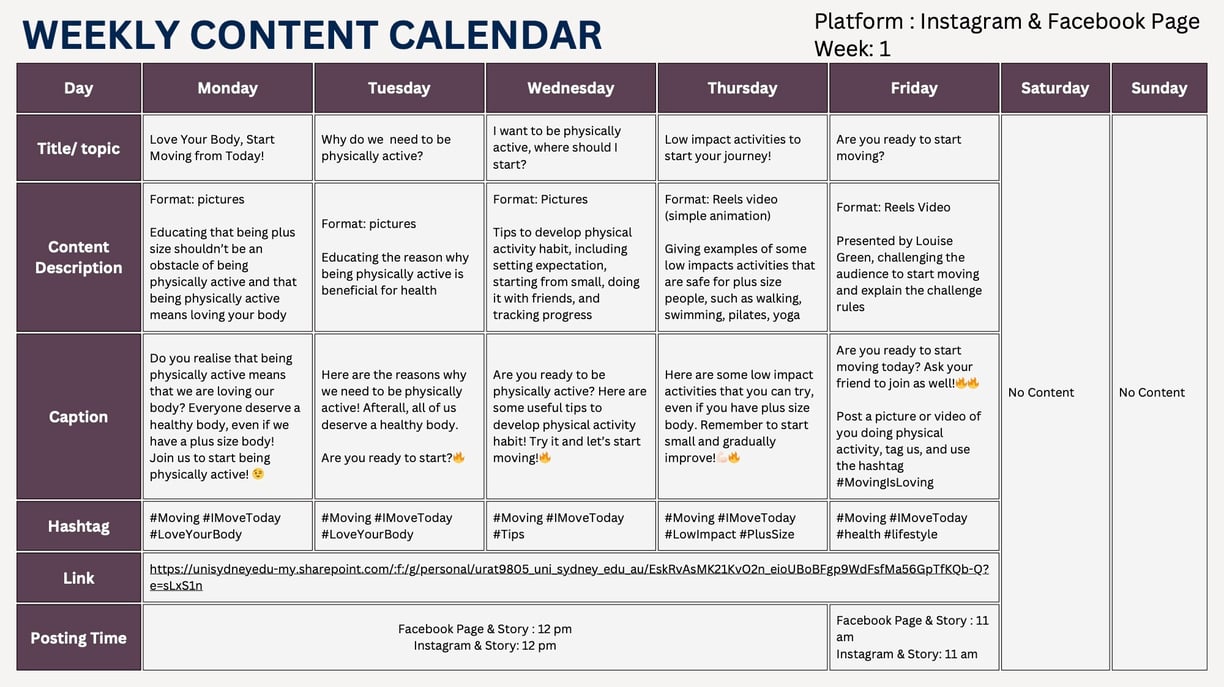
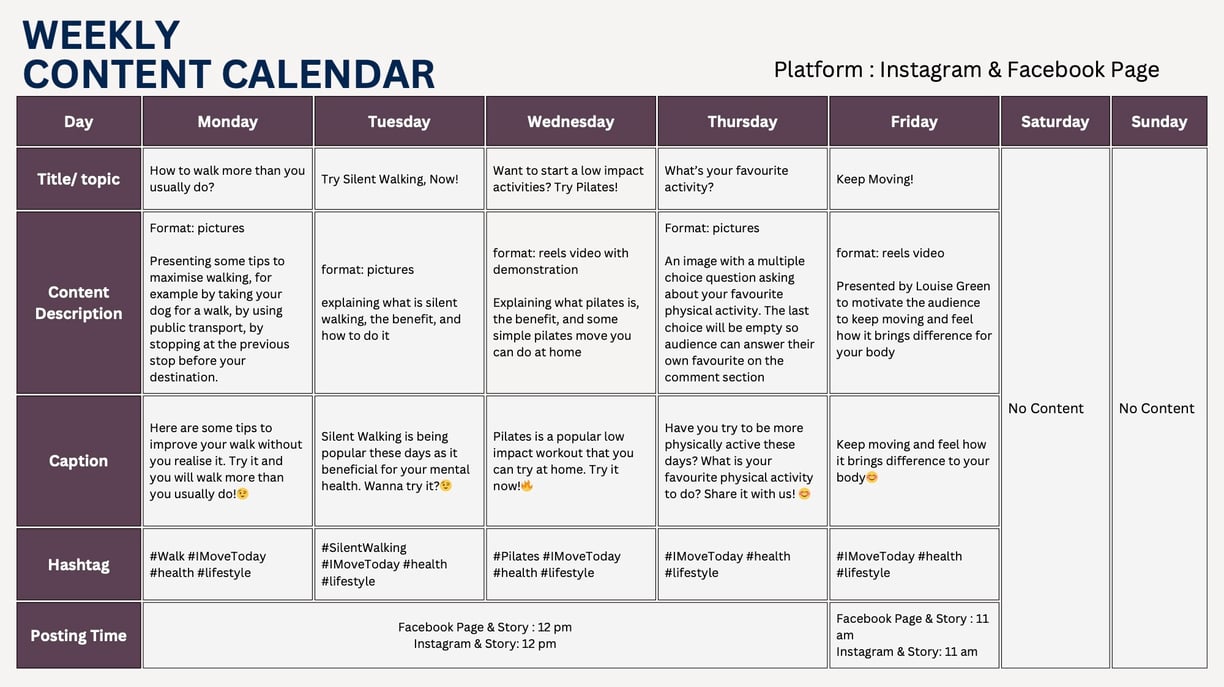


Visualisation of week 1 content
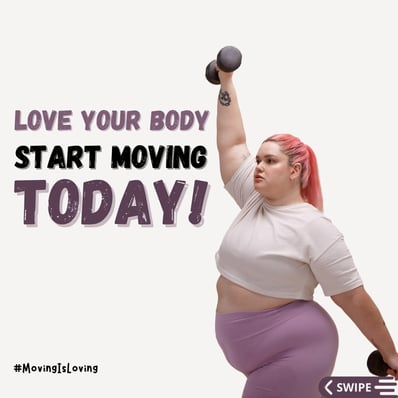
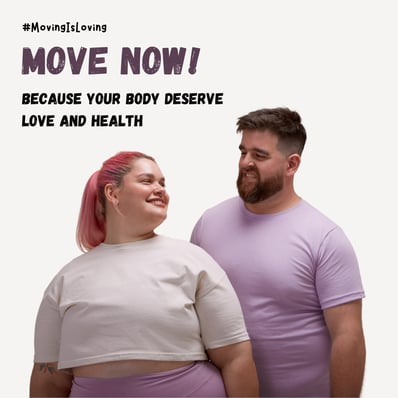

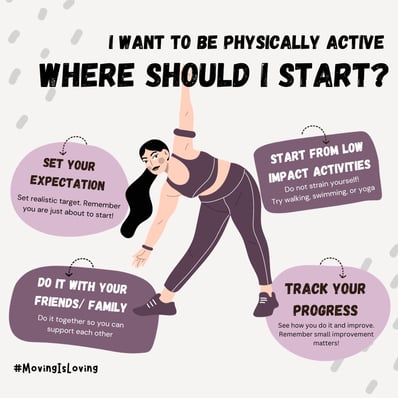
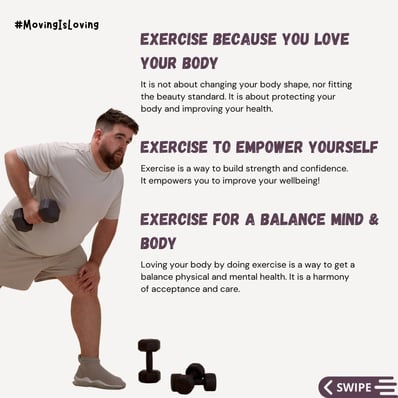
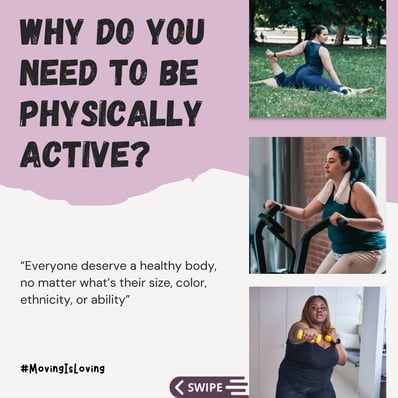








References:
Body Image Movement. (2019). About the Movement - Body Image Movement. Body Image Movement. https://bodyimagemovement.com/about/
Cohen, R., Irwin, L., Newton-John, T., & Slater, A. (2019). #bodypositivity: A content analysis of body positive accounts on Instagram. Body Image, 29(29), 47–57. https://doi.org/10.1016/j.bodyim.2019.02.007
Dixon, S. J. (2023a, February 24). Global Facebook user age & gender distribution 2018 | Statistic. Statista. https://www.statista.com/statistics/376128/facebook-global-user-age-distribution/
Dixon, S. J. (2023b, August 25). Distribution of Instagram users worldwide as of January 2023, by age group. Statista; Statista. https://www.statista.com/statistics/325587/instagram-global-age-group/
Hutchinson, J. (2019). Digital first personality: Automation and influence within evolving media ecologies. Convergence: The International Journal of Research into New Media Technologies, 26(5-6), 135485651985892. https://doi.org/10.1177/1354856519858921
Jenkins, H., Ford, S., & Green, J. (2013). Spreadable Media : Creating Value and Meaning in a Networked Culture. New York University Press.
Sprout Social. (2023). Best Times to Post on Social Media in 2023. Sprout Social. https://sproutsocial.com/insights/best-times-to-post-on-social-media/#:~:text=The%20best%20times%20to%20post%20on%20Instagram%20are%20Mondays%2C%20Tuesdays
